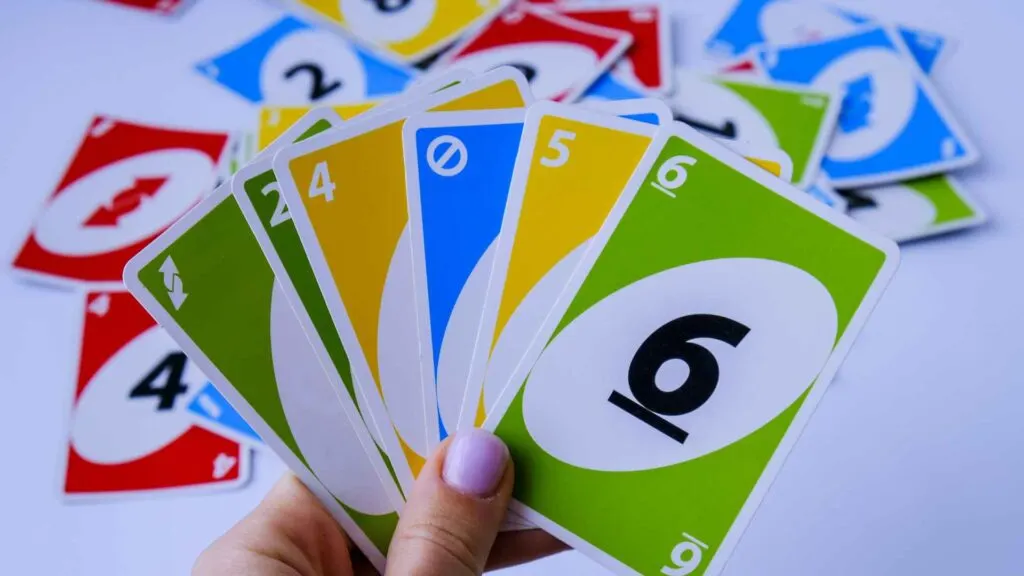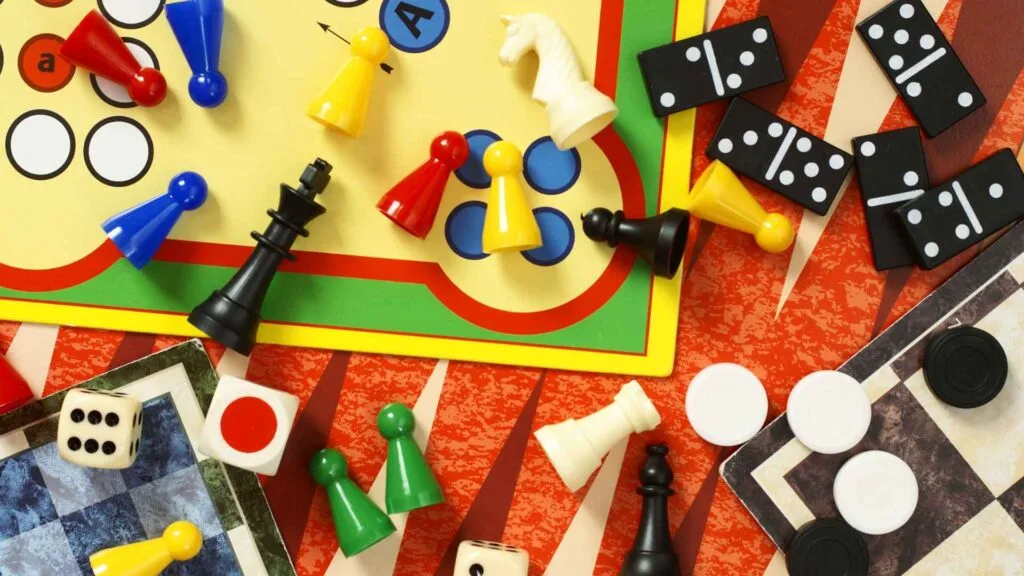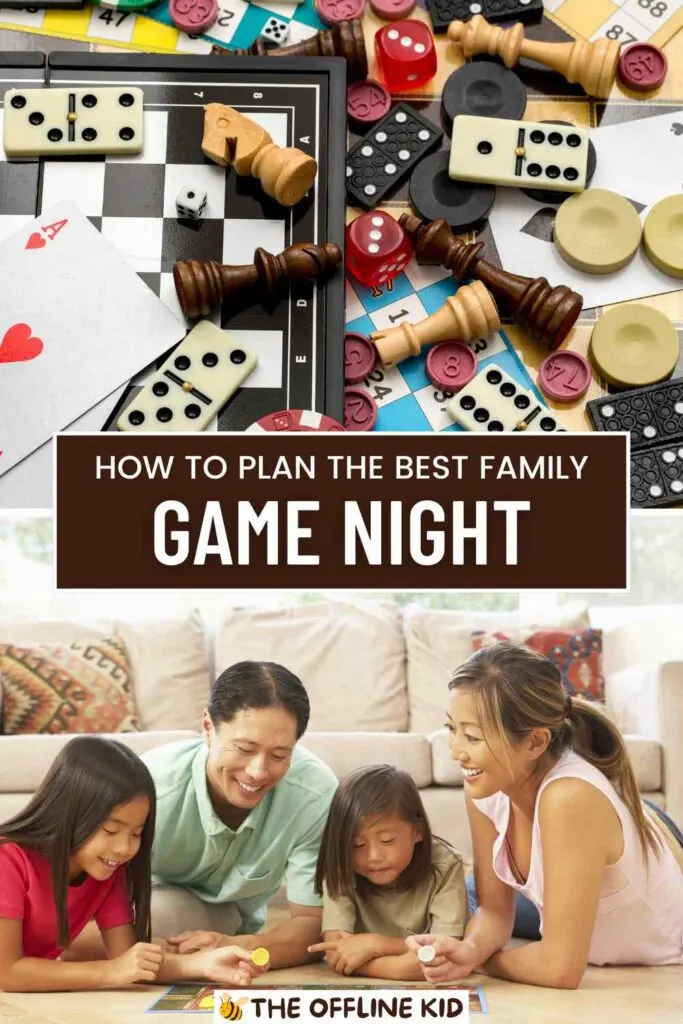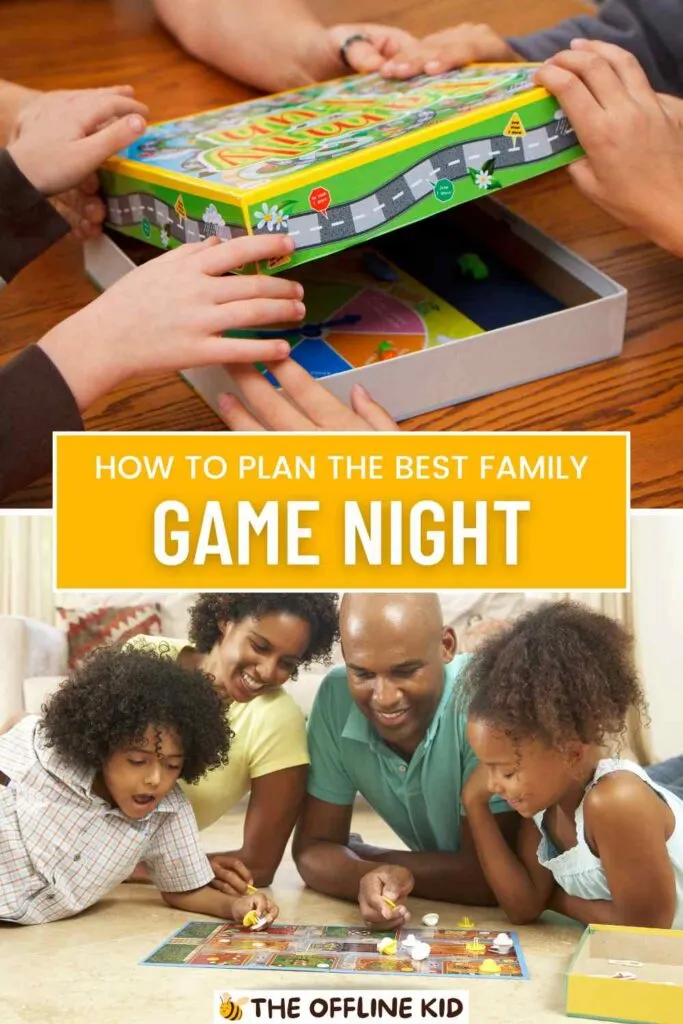Family game nights are a fantastic way to bond and create lasting memories.
In this ultimate guide, we’ll cover everything from choosing the right games to creating the perfect atmosphere, ensuring a fun and memorable experience for everyone.
Get ready to transform your family game night into an unforgettable tradition!
Getting Started
Choosing the Right Date and Time For Family Game Night
Finding a Suitable Day for Everyone:
- Consult the Family Calendar: Look for a day when everyone is free from commitments. Weekends or Friday evenings often work well.
- Consistency is Key: Consider making it a recurring event, such as the first Friday of every month. This builds anticipation and makes it easier to plan around.
- Be Flexible: If a conflict arises, be open to rescheduling. The goal is to ensure everyone can participate and enjoy the time together.
Ensuring a Relaxed Atmosphere:
- Avoid Busy Times: Choose a time when everyone can unwind, such as after dinner or on a lazy Sunday afternoon.
- Consider Bedtimes: For families with young children, start early enough to finish before bedtime. For older kids, a later start can add to the excitement.
- Account for Meals: Plan around meal times to avoid interruptions. Either eat before starting or plan for a mid-game meal break.
Setting Up the Space
Creating a Cozy and Inviting Environment:
- Comfortable Seating: Ensure there’s enough comfortable seating for everyone. Floor cushions or bean bags can add a fun touch.
- Adequate Lighting: Good lighting is essential, especially for board games. Soft, warm lighting can create a cozy atmosphere, while bright light is necessary for reading game instructions and cards.
- Declutter the Area: Clear away any unnecessary items to make space for games and snacks. A clean, organized space helps keep the focus on fun.
Considerations for Different Game Types:
- Board Games: A large table or a flat surface is ideal for board games. Make sure everyone can easily reach the game pieces and cards.
- Card Games: A smaller table works well for card games. Ensure there’s enough space to comfortably hold cards and any additional game components.
- Video Games: For video game nights, arrange seating around the TV or monitor. Make sure everyone has a good view and that controllers are charged and ready.
- Outdoor Games: If weather permits, take the fun outside. Set up in a spacious yard or a local park. Bring blankets, portable chairs, and tables if needed.
Final Touches
Invitations and Reminders:
- Send Invites: For special game nights, consider sending out fun invitations. This can be a simple text, email, or even a creative paper invite.
- Set Reminders: As the date approaches, send out reminders to keep the excitement alive and ensure everyone remembers the plan.
Gathering Supplies:
- Game Supplies: Make sure all games are in good condition with all necessary pieces. Have a variety of games ready to suit different preferences.
- Snacks and Drinks: Stock up on favorite snacks and drinks. Having everything ready ahead of time prevents interruptions during the game.
By carefully planning the date, time, and setup for your family game night, you’re setting the stage for a fun and memorable evening. With everyone on board and the environment just right, you’re well on your way to creating an event that the whole family will look forward to time and time again.

Game Selection
Age-Appropriate Games
Games for Young Children:
- Candy Land: A simple, colorful board game perfect for preschoolers and early elementary-aged children.
- Chutes and Ladders: Another classic, easy-to-understand game that helps teach counting and patience.
- Memory Games: Various themed memory matching games can engage young minds and improve cognitive skills.
Games for Teenagers:
- Codenames: A strategic word game that challenges players to think creatively and make connections.
- Ticket to Ride: A fun and competitive game where players build train routes across the country.
- Catan: A resource management and strategy game that’s perfect for older kids who enjoy a bit of complexity.
Games for Mixed-Age Groups:
- Uno: A fast-paced card game that’s easy to learn and fun for all ages.
- Pictionary: A drawing and guessing game that can be hilarious and engaging for everyone.
- Bingo: Customizable and adaptable for all ages, Bingo is simple and inclusive.
Game Types
Board Games:
- Monopoly: The classic game of buying, trading, and developing properties. Ideal for a longer game night.
- Scrabble: A word game that combines luck and strategy, perfect for those who enjoy a linguistic challenge.
- The Game of Life: Simulates a person’s journey through life, with career choices, marriage, and children.
Card Games:
- Exploding Kittens: A fun and quirky game that’s quick to learn and full of surprises.
- Skip-Bo: A sequential card game that’s both fun and competitive.
- Phase 10: A rummy-type card game with a twist, offering a mix of strategy and luck.
Outdoor Games:
- Cornhole: A bean bag toss game that’s easy to set up and fun for all ages.
- Capture the Flag: Perfect for larger groups and great for getting everyone active.
- Frisbee Golf: Set up a course in your yard or a park and enjoy a casual, fun competition.
DIY Games:
- Charades: No equipment needed, just your imagination and acting skills.
- Trivia Night: Create your own trivia questions based on family interests and compete in teams.
- Scavenger Hunt: Plan a themed hunt around the house or yard with clues and small prizes.
Top Game Recommendations
List of Popular Family Games:
- Catan: Engage in a strategic game of trading and building.
- Pros: Encourages strategic thinking and negotiation.
- Cons: Can be complex for younger children.
- Codenames: Test your word association skills in this team-based game.
- Pros: Encourages creative thinking and teamwork.
- Cons: May be challenging for very young players.
- Ticket to Ride: Build train routes and connect cities.
- Pros: Easy to learn and engaging for a wide age range.
- Cons: Can become competitive and lengthy.
Pros and Cons of Each Game Type:
Board Games:
- Pros: Encourages face-to-face interaction and can be very engaging.
- Cons: Some games can be lengthy and require a significant time commitment.
Card Games:
- Pros: Usually quick and easy to learn, with minimal setup required.
- Cons: May lack the depth and engagement of some board games.
Outdoor Games:
- Pros: Great for physical activity and larger groups.
- Cons: Weather dependent and may require more space.
DIY Games:
- Pros: Highly customizable and can be tailored to your family’s interests.
- Cons: Requires creativity and planning to set up.
Selecting the right games for your family game night is crucial to ensuring everyone has a great time. By considering the ages and interests of your family members and mixing up the types of games you play, you can create an engaging and fun experience that everyone will look forward to.

Snacks and Refreshments
Choosing the Right Snacks
Quick and Easy Snack Ideas:
- Popcorn: A classic and easy-to-make snack that can be sweet, salty, or savory.
- Veggie Platter: A healthy option with a variety of vegetables and a tasty dip.
- Fruit Skewers: Colorful and refreshing, these are easy to eat and can be prepared in advance.
- Chips and Dip: Choose from a variety of dips like salsa, guacamole, or hummus to keep everyone satisfied.
Healthy Options vs. Treat Options:
- Healthy Options:
- Nuts and Seeds: A protein-packed snack that’s easy to share.
- Yogurt Parfaits: Layer yogurt with granola and fruit for a delicious and healthy treat.
- Whole Grain Crackers with Cheese: Simple and satisfying, offering a good balance of carbs and protein.
- Treat Options:
- Cookies and Brownies: Homemade or store-bought, these sweet treats are always a hit.
- Candy Bowl: A selection of candies for a quick sugar boost.
- Ice Cream Sundaes: Set up a sundae bar with various toppings for a fun and interactive dessert.
Themed Snacks
Matching Snacks to the Game Theme:
- Pirate-Themed Night: Serve gold-wrapped chocolate coins, “seaweed” snacks (dried seaweed or green fruit roll-ups), and “fish and chips” (goldfish crackers and potato chips).
- Movie Night: Create a cinema-style snack bar with popcorn, candy, nachos, and soft pretzels.
- Holiday-Themed Games: For a Christmas-themed game night, serve hot cocoa, gingerbread cookies, and candy canes.
Creative Presentation Ideas:
- Snack Boards: Arrange snacks on a large board or platter for a visually appealing and easy-to-access setup.
- Mini Servings: Use small cups or bowls to portion out individual servings of snacks, reducing mess and making it easy to grab and go.
- DIY Snack Stations: Set up stations where family members can customize their snacks, like a popcorn seasoning bar or a make-your-own trail mix station.
Beverage Ideas
Kid-Friendly Drinks:
- Fruit Punch: A colorful and refreshing option that can be served in fun glasses.
- Smoothies: Blend up a variety of fruits with yogurt or milk for a healthy and delicious drink.
- Sparkling Water with Fruit: Add a splash of fun with flavored sparkling water and slices of fresh fruit.
Special Drinks for Adults:
- Mocktails: Create alcohol-free cocktails that are fancy and flavorful.
- Coffee and Tea: Offer a selection of coffees and teas for a warm and cozy beverage option.
- Signature Drink: Create a special drink for the night, like a themed punch or a classic cocktail, to add a touch of sophistication.
Presentation Tips:
- Drink Dispensers: Use clear drink dispensers to showcase colorful punches or infused waters.
- Fun Straws and Cups: Make drinks more appealing with fun straws, themed cups, or even personalized mugs.
- Ice Options: Consider flavored ice cubes (like mint or fruit-infused) to add an extra touch to drinks.
Final Preparations
Prepping Ahead:
- Make-Ahead Snacks: Prepare as many snacks as possible in advance to reduce stress on the night of the event.
- Beverage Stations: Set up beverage stations ahead of time with all necessary supplies, like cups, straws, and napkins.
- Easy Cleanup: Use disposable plates, cups, and utensils to make cleanup a breeze, or have a plan for quick cleanup with reusable items.
Engaging the Family:
- Snack Helpers: Get the family involved in snack preparation. Kids can help arrange veggie platters or mix up fruit punch.
- Vote for Favorites: Let everyone have a say in what snacks are served by taking a vote beforehand.
By thoughtfully choosing and preparing snacks and refreshments, you can enhance the family game night experience. With a mix of healthy options, treats, themed snacks, and fun drinks, everyone will stay energized and engaged throughout the evening.

Establishing Rules and Guidelines
Game Night Etiquette
Fair Play and Sportsmanship:
- Encourage Positive Behavior: Remind everyone that the goal is to have fun. Emphasize the importance of being gracious whether winning or losing.
- Model Good Sportsmanship: Lead by example. Show your family how to be competitive in a friendly manner and how to handle both victories and defeats gracefully.
- Praise and Encourage: Give positive reinforcement to players who demonstrate good sportsmanship. This can help build a supportive and fun environment.
Handling Disagreements:
- Set Clear Rules: Before starting, ensure everyone understands the rules of the game. Clear rules help prevent many potential disagreements.
- Use a Referee: For competitive games, designate a family member to act as the referee to make impartial decisions if disputes arise.
- Take a Break: If tensions rise, suggest taking a short break. A few minutes away from the game can help everyone cool down and return with a better attitude.
House Rules
Customizing Rules to Fit Your Family’s Style:
- Adapt and Adjust: Feel free to modify game rules to better suit your family’s preferences. For example, you can shorten the duration of a game or simplify complex rules for younger children.
- Create Family-Specific Rules: Develop unique house rules that make the games more enjoyable for your family. For example, in Monopoly, you could have a rule that landing on “Free Parking” wins a bonus.
- Rotate Rule Creators: Allow different family members to create or suggest house rules. This keeps things interesting and gives everyone a sense of ownership.
Example House Rules:
- No Phones: Establish a no-phone rule during game night to ensure everyone is fully present and engaged.
- Time Limits: Set time limits for each game to keep the night moving and give everyone a chance to play multiple games.
- Golden Rule: Have a “Golden Rule” that trumps all others, like “Have Fun!” or “Be Kind.” This can serve as a guiding principle if conflicts arise.
Establishing Fairness
Taking Turns:
- Rotation System: Use a simple rotation system to ensure everyone gets a turn to choose a game or be the first player.
- Random Selection: Use a random method, such as drawing straws or rolling a die, to decide who goes first in each game.
Balancing Skill Levels:
- Team Play: For games where skill levels vary widely, consider playing in teams to balance out the strengths and weaknesses of individual players.
- Handicaps: Introduce handicaps in certain games to level the playing field. For example, giving younger players a head start in a race or extra resources in a strategy game.
Creating a Comfortable Environment
Ensuring Everyone Feels Included:
- Inclusive Language: Use inclusive and encouraging language to make sure everyone feels welcome and valued.
- Participation Encouragement: Gently encourage participation from everyone, but respect if someone wants to sit out or take a break.
Managing Expectations:
- Discuss Goals: At the start of the night, talk about what everyone wants to get out of the game night. Whether it’s winning, having fun, or simply spending time together, understanding each person’s goal can help align expectations.
- Stay Flexible: Be open to changing plans if a game isn’t going well or if someone suggests a different activity. Flexibility ensures that everyone continues to have a good time.
By establishing clear rules and guidelines, you create a foundation for a smooth and enjoyable game night. Setting expectations, encouraging good sportsmanship, and making sure everyone feels included will help foster a positive and fun atmosphere for your family game night.

Creating a Fun Atmosphere
Music and Background Noise
Choosing the Right Playlist:
- Family Favorites: Create a playlist with songs that everyone in the family enjoys. Consider upbeat, fun songs that enhance the lively atmosphere.
- Game-Appropriate Music: Match the music to the type of game you’re playing. For example, play epic soundtracks for adventure games or calming music for puzzle games.
- Interactive Music: Include songs that encourage singing along or dancing during breaks. This can add another layer of fun to the evening.
Soundtracks that Enhance the Game Experience:
- Themed Soundtracks: For themed game nights, find soundtracks that match the theme. For example, pirate music for a pirate-themed night or sci-fi tunes for a space-themed game.
- Instrumental Background Music: Use instrumental music to provide ambiance without distracting from the game. Classical, jazz, or movie scores work well.
Decorations and Themes
Simple Decoration Ideas:
- Table Setup: Decorate the table with themed tablecloths, game-related centerpieces, and colorful placemats.
- Room Décor: Add balloons, banners, and posters that match the theme of your game night.
- Lighting: Use string lights, lanterns, or themed lighting to create a cozy and festive atmosphere.
Themed Game Nights:
- 80s Night: Everyone dresses up in 80s attire, and you play classic games from that era. Serve retro snacks like Pop Rocks and soda floats.
- Movie Night: Choose games based on popular movies or characters. Decorate with movie posters and serve popcorn and candy.
- Holiday-Themed Night: Incorporate decorations and games that match the current holiday season, like Halloween, Christmas, or Easter-themed games and snacks.
Engaging Activities
Mini-Games and Challenges:
- Trivia Rounds: Include trivia rounds between games. Choose questions based on family interests or the night’s theme.
- Dance-Offs: Have mini dance-offs during breaks. Use a dance game like Just Dance or create your own dance challenge.
- Craft Stations: Set up a craft station where family members can make simple crafts related to the game theme, like decorating game pieces or creating scoreboards.
Photo Booths and Memory Making:
- Photo Booth Setup: Create a photo booth with themed props and a backdrop. Encourage everyone to take fun pictures throughout the night.
- Memory Scrapbook: Keep a scrapbook of game nights with photos, game scores, and funny moments. Add a new page for each game night to look back on later.
Prizes and Rewards
Adding a Competitive Edge with Mini-Competitions:
- Leaderboards: Keep a leaderboard to track wins and high scores over multiple game nights. Offer small rewards for reaching milestones.
- Family Trophies: Create or buy a fun trophy that gets passed to the winner of each game night. This can be a simple DIY project with a small prize attached.
Ideas for Fun and Inexpensive Prizes:
- Homemade Coupons: Offer coupons for special privileges, like choosing the next movie for family night or picking a favorite meal.
- Small Treats: Give out small treats like candies, stickers, or toys as prizes.
- Certificates: Make fun certificates or awards for categories like “Best Sportsmanship,” “Most Creative Player,” or “Most Wins.”
Final Touches
Ensuring Everyone Has Fun:
- Inclusive Activities: Plan activities that everyone can enjoy, regardless of age or skill level. Rotate game types to keep everyone engaged.
- Encouraging Participation: Make sure to involve everyone in the planning and setup process. This can help build excitement and make everyone feel included.
Capturing the Moment:
- Taking Photos and Videos: Capture moments throughout the night. Assign someone as the “family photographer” to ensure you don’t miss any fun memories.
- Sharing Memories: Share photos and videos with family members afterward. Consider creating a shared album or using a family group chat.
Creating a fun atmosphere is key to a successful family game night. By adding music, decorations, engaging activities, and prizes, you can enhance the overall experience and ensure that everyone has a fantastic time.
Keeping Everyone Engaged
Involving All Ages
Tips for Keeping Younger Children Engaged:
- Simple and Short Games: Choose games that are easy to understand and play quickly, like Candy Land or Memory.
- Interactive Elements: Incorporate games with physical movement or hands-on activities, such as Simon Says or a simple scavenger hunt.
- Frequent Breaks: Allow for short breaks between games to prevent fatigue and maintain interest. Use this time for snacks or a quick dance break.
Ensuring Teenagers Have Fun:
- Challenging Games: Select games that require strategy and critical thinking, such as Codenames or Catan.
- Social Interaction: Encourage games that promote social interaction and teamwork, like Pictionary or charades.
- Involve Them in Planning: Give teenagers a role in planning the game night, from choosing games to setting up the space. This helps them feel invested and excited.
Rotating Games
How to Rotate Games to Keep the Excitement:
- Mix Game Types: Alternate between different types of games, such as a board game followed by a card game, then an active game.
- Short and Long Games: Balance shorter games with longer ones to maintain variety and keep everyone’s attention.
- Random Selection: Use a random method, like drawing game names from a hat, to decide the next game. This adds an element of surprise.
Balancing Short and Long Games:
- Start with Quick Wins: Begin the night with a few short games to get everyone warmed up and excited.
- Mid-Session Main Event: Feature a longer, more involved game in the middle of the evening when energy levels are high.
- End on a High Note: Conclude with a quick, fun game that leaves everyone in good spirits.
Mini-Competitions and Prizes
Adding a Competitive Edge with Mini-Competitions:
- Mini-Tournaments: Set up mini-tournaments for certain games, with winners advancing to the next round. This works well for card games or video games.
- Score Tracking: Keep track of points or wins throughout the night and award a grand prize to the overall winner.
- Team Challenges: Form teams and compete in team-based games or challenges, fostering cooperation and friendly competition.
Ideas for Fun and Inexpensive Prizes:
- Family Bragging Rights: Offer fun, non-tangible prizes like choosing the next game night’s theme or being “Game Master” for the next event.
- DIY Awards: Create homemade awards or certificates for various achievements, such as “Best Strategy” or “Most Creative Move.”
- Small Gifts: Consider small, inexpensive gifts like a favorite candy, a fun keychain, or a family movie night voucher.
Keeping the Energy Up
Maintaining Engagement Throughout the Night:
- Encourage Interaction: Choose games that require players to interact and communicate, keeping everyone involved.
- Be Enthusiastic: Show enthusiasm and excitement for each game. Your positive attitude can be contagious and help maintain a lively atmosphere.
- Monitor Energy Levels: Pay attention to the group’s energy. If people seem tired or restless, switch to a more active game or take a break.
Break Activities:
- Quick Stretches: Lead a quick stretching session to keep everyone energized.
- Mini Dance Party: Play a favorite song and have a short dance party to break up the games and keep spirits high.
- Snack Breaks: Use snack breaks as a time to chat and recharge before diving into the next game.
Keeping everyone engaged is crucial for a successful family game night. By involving all ages, rotating games, adding mini-competitions, and keeping the energy up, you can ensure that everyone remains enthusiastic and has a great time throughout the evening.
Handling Challenges
Dealing with Game Night Fatigue
Recognizing When to Take Breaks:
- Watch for Signs: Look for signs of fatigue, such as yawning, fidgeting, or loss of interest. If you notice these, it might be time for a break.
- Scheduled Breaks: Plan scheduled breaks throughout the night to give everyone a chance to rest and recharge.
- Flexible Timing: Be flexible with your schedule. If a game is dragging on or if players seem tired, don’t hesitate to take an unscheduled break.
Switching to Lighter Activities:
- Easy, Low-Effort Games: Have a few low-effort games on hand, like Bingo or card games, which don’t require intense concentration.
- Relaxing Activities: Consider switching to a relaxing activity, such as a storytelling game or watching a short, fun video clip.
- Snack and Chat: Use break time for snacks and casual conversation. This can help recharge everyone’s energy and foster bonding.
Resolving Conflicts
Tips for Mediating Disputes:
- Stay Calm: If a conflict arises, remain calm and composed. Your calm demeanor can help de-escalate the situation.
- Listen to Both Sides: Give everyone a chance to express their side of the story. Listening can often resolve misunderstandings quickly.
- Fair Solutions: Look for fair solutions that consider everyone’s feelings. Sometimes a simple compromise can go a long way.
Encouraging Positive Communication:
- Set the Tone: At the start of the night, remind everyone about the importance of positive communication and respect.
- Praise Positive Behavior: Acknowledge and praise positive behavior and good sportsmanship throughout the night.
- Use “I” Statements: Encourage family members to use “I” statements to express their feelings without blaming others. For example, “I feel upset when…” instead of “You always…”
Handling Game Preferences
Balancing Different Preferences:
- Take Turns Choosing: Rotate who gets to choose the next game. This ensures that everyone gets a chance to play their favorite game.
- Variety is Key: Plan a variety of games to cater to different preferences. Include a mix of competitive, cooperative, and individual games.
- Respect Preferences: If someone really doesn’t want to play a particular game, respect their preference and choose another option. The goal is for everyone to have fun.
Encouraging Trying New Games:
- Introduce Gradually: Introduce new games gradually, mixing them in with familiar favorites. This can help ease resistance to new experiences.
- Explain Benefits: Explain the fun aspects of a new game and why you think the family will enjoy it.
- Make it a Challenge: Turn trying a new game into a fun challenge. Offer a small reward for giving it a try, even if it’s just for a few minutes.
Dealing with Limited Attention Spans
Short Attention Span Solutions:
- Quick Games: Have a selection of quick, easy-to-play games that can keep attention without a long commitment.
- Interactive Games: Choose games that require active participation, like charades or Pictionary, to keep everyone engaged.
- Break it Up: Break longer games into shorter segments or mini-games to maintain interest.
Engaging Everyone:
- Role Play: Assign different roles or tasks during the game to keep everyone involved. For example, one person can be the scorekeeper or the rule enforcer.
- Switch Roles: Switch roles and responsibilities throughout the night to keep things fresh and engaging.
Handling challenges is a natural part of planning the best family game night. By recognizing and addressing game night fatigue, resolving conflicts, balancing preferences, and managing attention spans, you can ensure that everyone remains engaged and has a positive experience.


